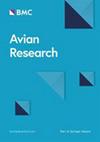斯里兰卡的笑鸫:一种被混淆为笑鸫的咿呀学语者的生态学和系统发育评估
IF 1.7
2区 生物学
Q1 ORNITHOLOGY
引用次数: 0
摘要
灰头笑鸫(Argya cinereifrons)是斯里兰卡特有的一种,历史上一直被认为是笑鸫属的一种。然而,根据系统发育的证据,最近的研究提出了一种新的分类,该物种属于Argya属(真正的babblers)。尽管基因信号显示与真正的吟鸫有亲缘关系,正如它的名字所暗示的那样,灰头笑鸫(AHLT)与印度-喜马拉雅地区的其他笑鸫在形态上表现出惊人的相似性。在这里,我们试图通过重建babblers的分子系统发育,并将其与两个相关群体的关键形态,羽毛和声音特征进行比较,来解决该物种表型和系统发育信号的不一致。我们假设印度大陆湿常绿森林和斯里兰卡南部湿热带雨林中Garrulax的表型和发声的趋同一直使分类学家感到困惑。利用贝叶斯推断,利用4个线粒体和7个核基因区域重建了系统发育关系。分子系统发育树将AHLT与印度的大灰色Babbler (A. malcolmi)作为Argya属的姐妹分类单元。基于身体大小、形状、羽毛颜色和声音特性的分层聚类导致ALTH与牙牙学语者或笑画眉的位置不一致。因此,表型和基因型不一致被观察到。我们的研究结果表明,表型进化的趋同模式可以混淆历史上和最近在高度分化的群体中划分的分类学界限,如亚洲牙牙学语者。本文章由计算机程序翻译,如有差异,请以英文原文为准。
Sri Lanka's laughingthrush: An ecological and phylogenetic assessment of a babbler confused for a laughingthrush
The Ashy-headed Laughingthrush (Argya cinereifrons), a species endemic to Sri Lanka, has been historically considered a laughingthrush in the genus Garrulax. However, based on phylogenetic evidence, recent studies have suggested a new classification for the species under the genus Argya (true babblers). Despite the genetic signal showing affinity to true babblers Argya, as its common name suggests, the Ashy-headed Laughingthrush (AHLT) shows remarkable morphological similarities to other laughingthrushes of the Indo-Himalayan region. Here we attempted to address this incongruence in phenotypic and phylogenetic signals in this species by reconstructing the molecular phylogeny of babblers and comparing that with the key morphological, plumage, and vocal features of the two concerned groups. We hypothesized that the convergence of phenotype and vocalization of Garrulax in the wet evergreen forests of the Indian mainland and AHLT in the wet tropical rainforests of southern Sri Lanka has historically confused the taxonomists. The phylogenetic relationships were reconstructed using Bayesian inference using four mitochondrial and seven nuclear gene regions. The molecular phylogenetic tree placed the AHLT with India's Large Grey Babbler (A. malcolmi) as the sister taxon within the genus Argya. The hierarchical clustering based on body size, shape, plumage colour, and vocal properties resulted in the inconsistent placement of ALTH with babblers or laughingthrushes. Therefore, an incongruence in phenotype and genotype is observed. Our findings show that the convergent patterns of phenotypic evolution can confuse both historic and recent taxonomic delimitations in highly divergent groups such as Asian babblers.
求助全文
通过发布文献求助,成功后即可免费获取论文全文。
去求助
来源期刊

Avian Research
ORNITHOLOGY-
CiteScore
2.90
自引率
16.70%
发文量
456
审稿时长
46 days
期刊介绍:
Avian Research is an open access, peer-reviewed journal publishing high quality research and review articles on all aspects of ornithology from all over the world. It aims to report the latest and most significant progress in ornithology and to encourage exchange of ideas among international ornithologists. As an open access journal, Avian Research provides a unique opportunity to publish high quality contents that will be internationally accessible to any reader at no cost.
 求助内容:
求助内容: 应助结果提醒方式:
应助结果提醒方式:


